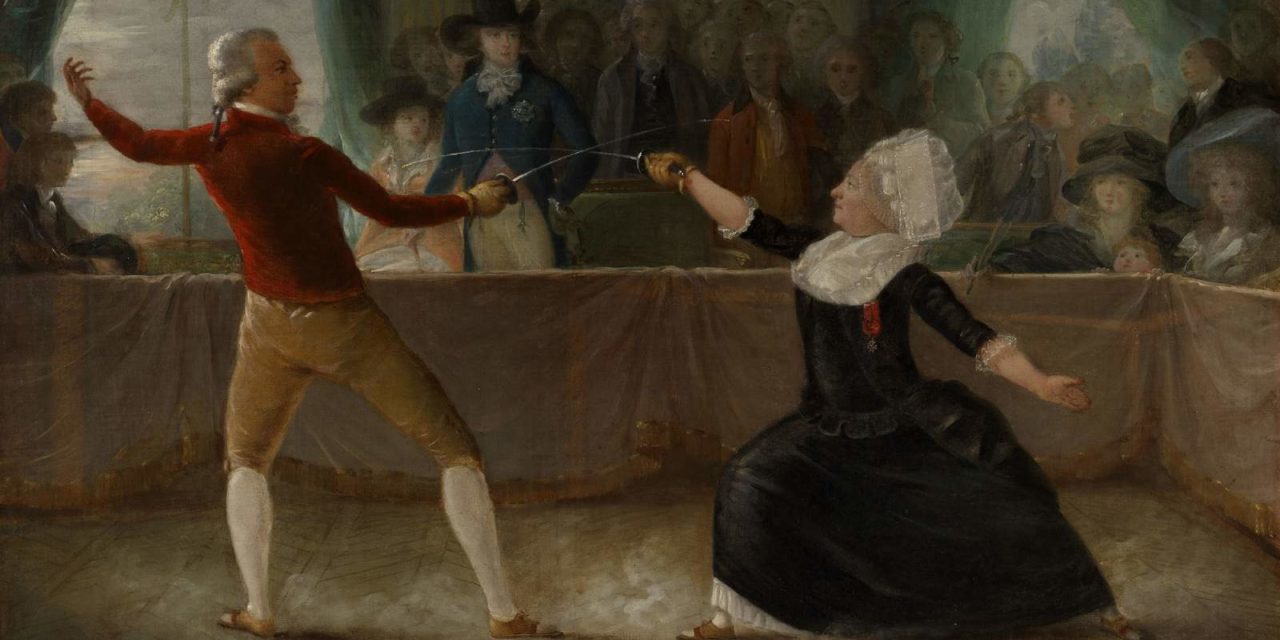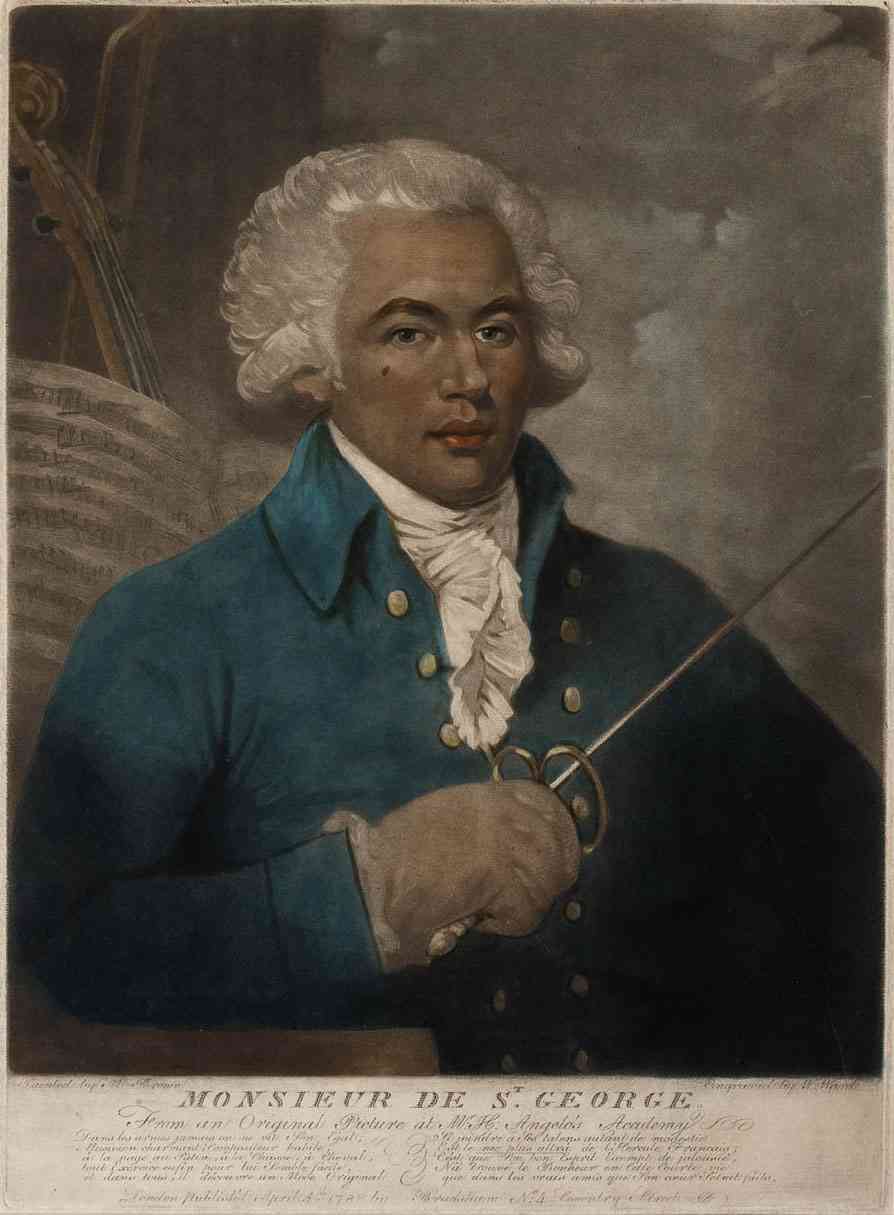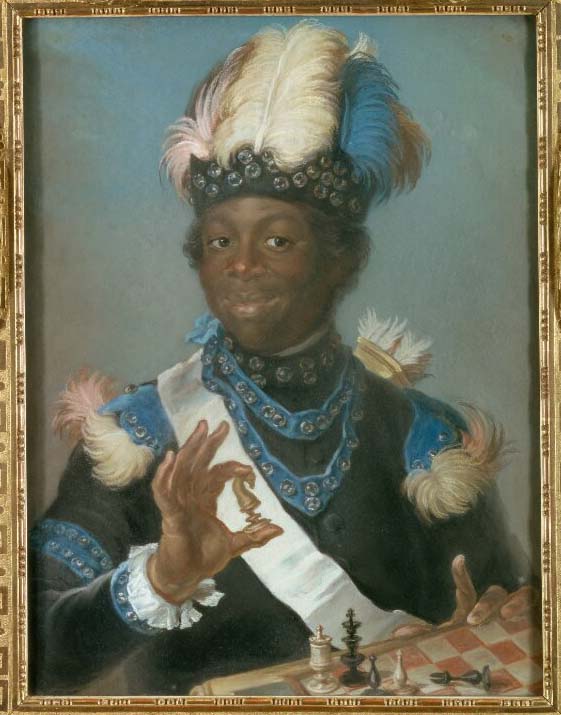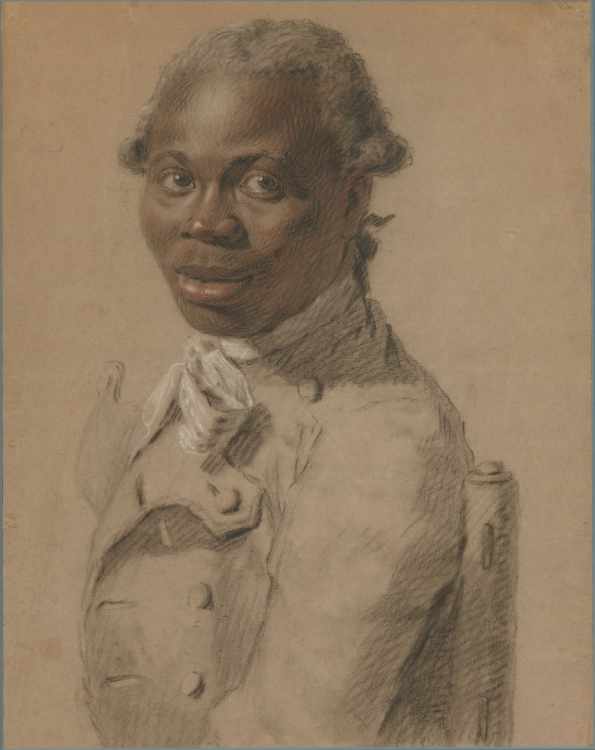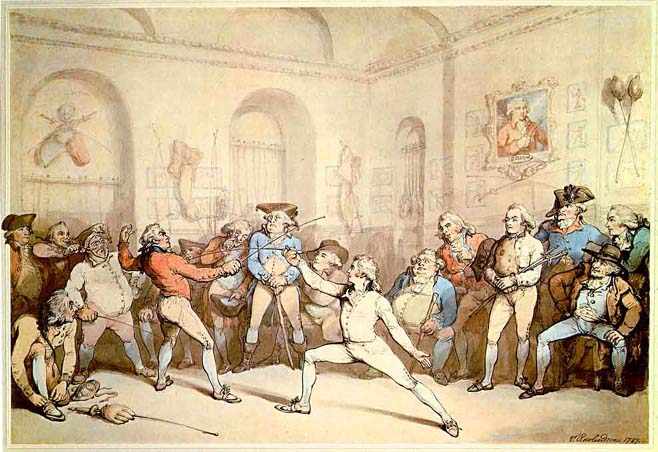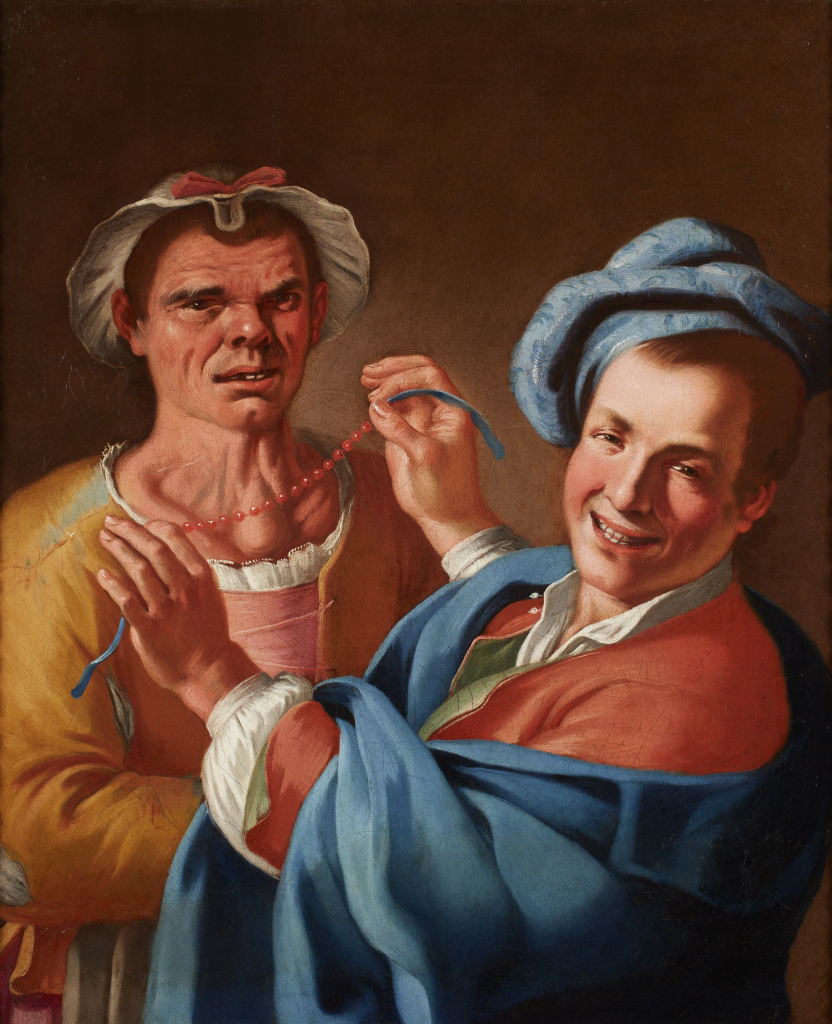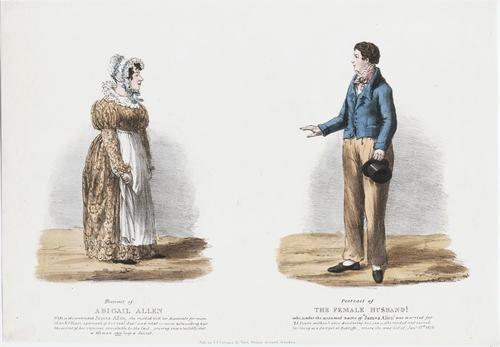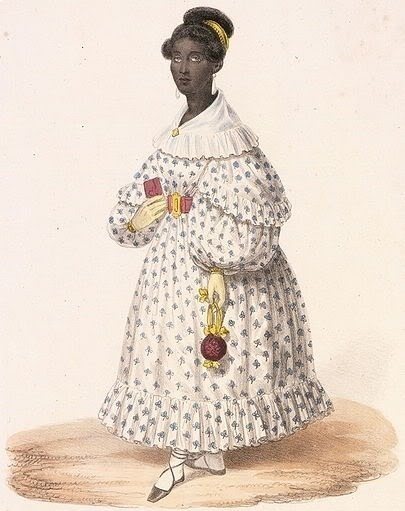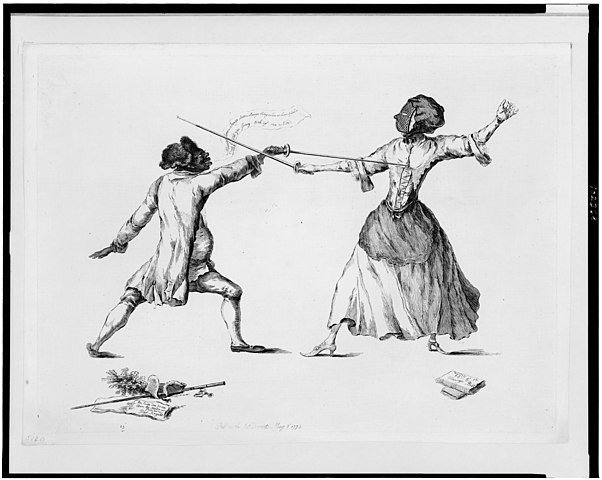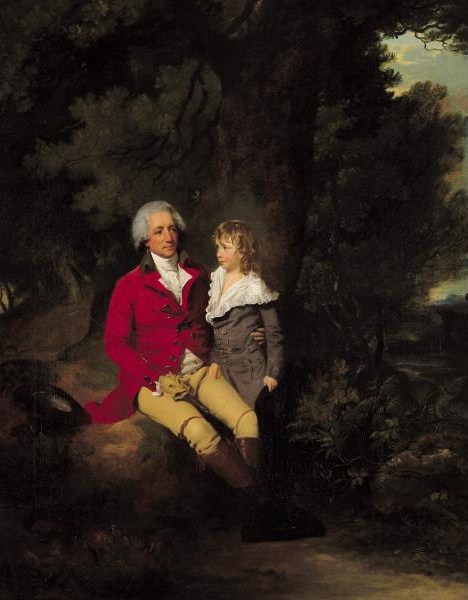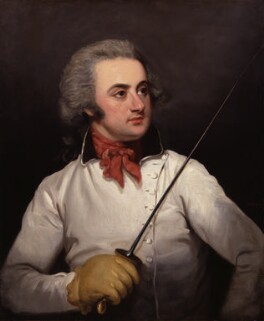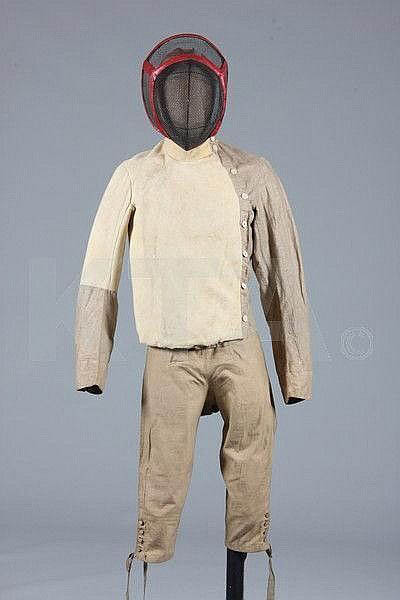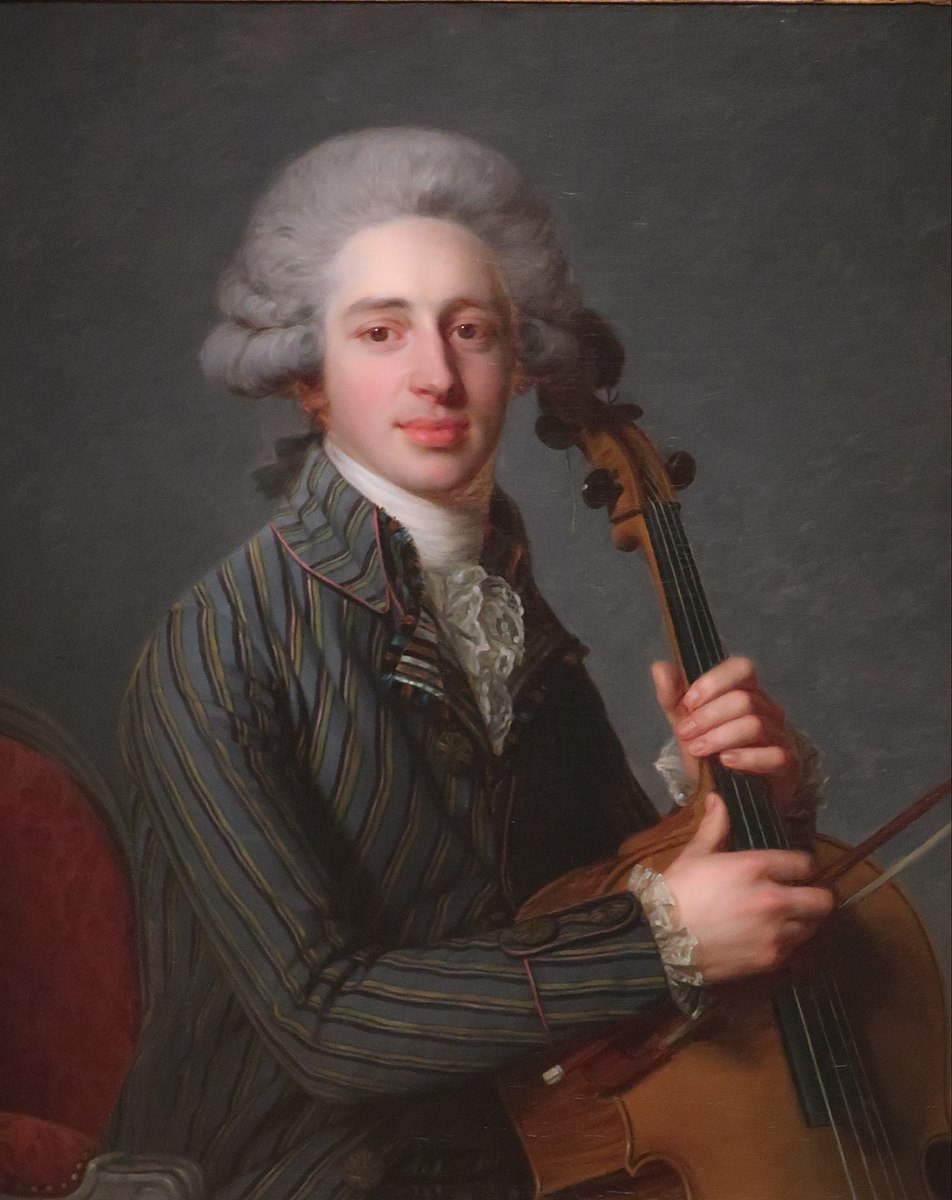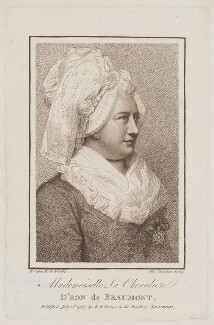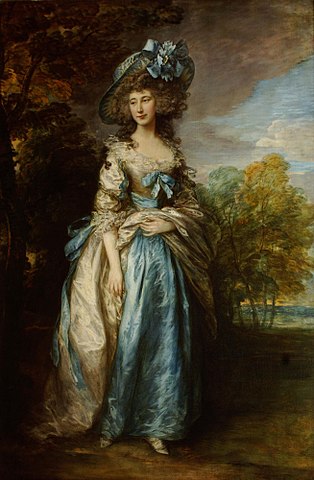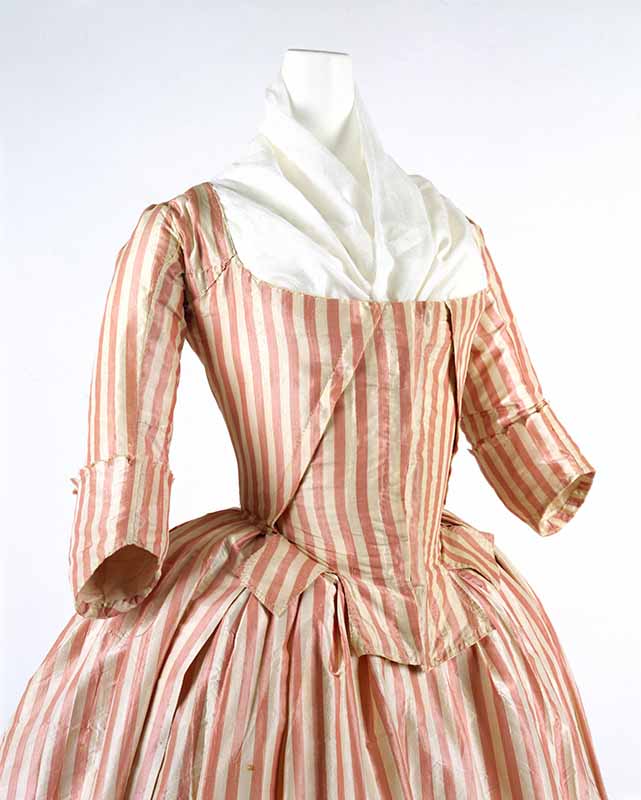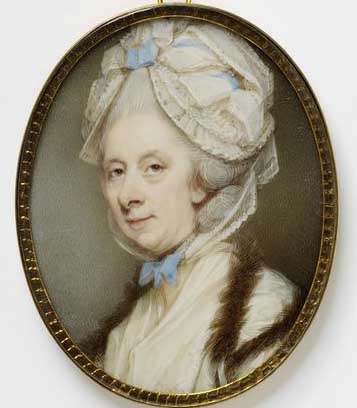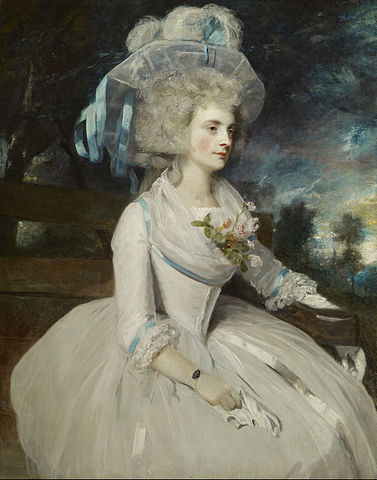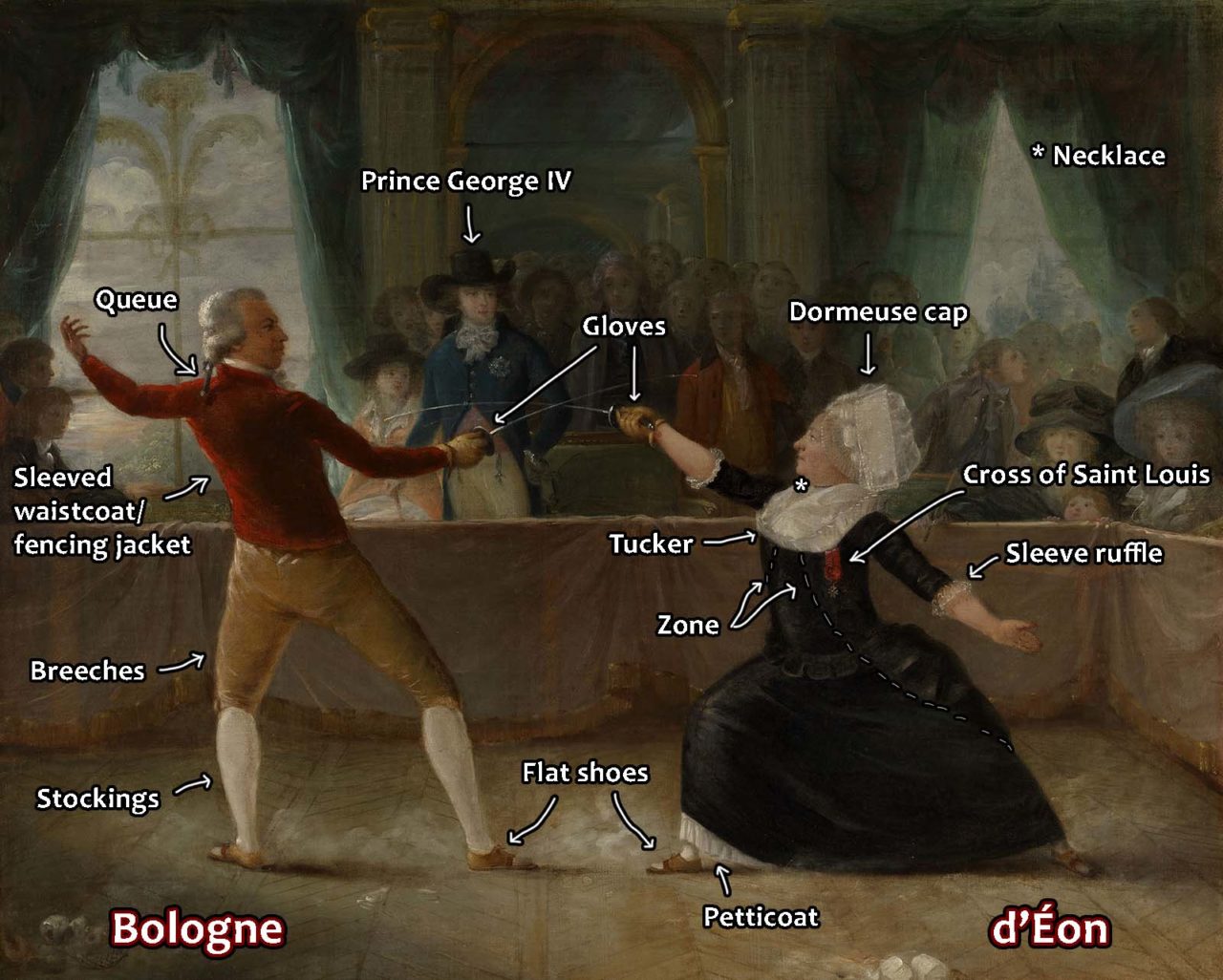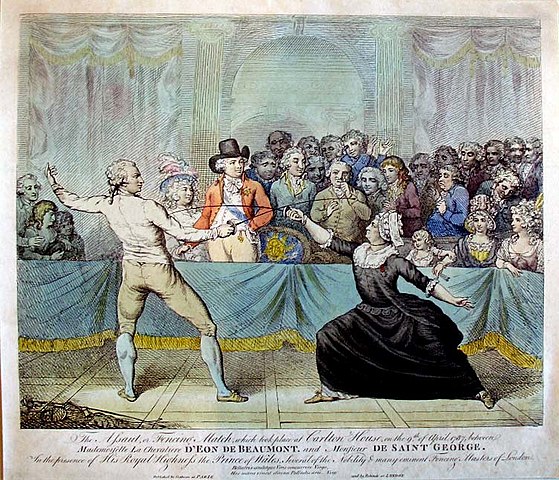This 18th-century painting commemorates an historic fencing match between two French knights: one an illegitimate Black nobleman and the other a gender nonconforming spy.
About the Portrait
This dramatic painting was created by Alexandre-Auguste Robineau to commemmorate a fencing match between Joseph Bologne, the Chevalier Saint-Georges, and Charles d’Éon de Beaumont, the Chevalier d’Éon, which occurred at the Prince of Wales’ Carlton House in London on April 9th, 1787 (RCT). The spar seems to have been staged as a test of skill, as both were respected as highly skilled fencers, and d’Éon earned money through matches (Brogan 87-88). Fencing was an exhibition sport, hence the crowd, and this particular duel became famous partially due to the exceptional nature of the participants. Not only was Bologne was of mixed race and d’Éon a woman, but both were favored subjects of gossip for their remarkable lives and abilities.
Alexandre-Auguste Robineau
Alexandre-Auguste Robineau (1747-1828) was a French painter, musician, and fellow fencer. He led dual careers of music (violin and composition, much like Bologne himself) and painting, though not much is known of his artistic work (Zaslaw). From the work we do have, it is clear he painted both in the grand-manner style of portraiture (Fig. 1) and in multi-figure scenes like the fencing match. He may have had a working or friendly relationship with Prince George IV as his patron; the Royal Collection Trust speculates that the paintings of Bologne and d’Eon were made for George and kept at Carlton House (RCT). (The Prince is visible in blue and silver in the background.)
Robineau painted several works in London around the events at Carlton in 1787. He was forty, Bologne forty-two, and d’Éon fifty-nine – meaning that this scene for the most part represents a group of people in the middle of their careers, rather than sprightly young things making a name for themselves in front of the twenty-five-year-old Prince of Wales.
Chevalier de Saint-George
Joseph Bologne de Saint-Georges (1745-1799) (Fig. 2) was born in Guadaloupe (a French Caribbean colony) to a wealthy white gentleman, George Bologne de Saint-Georges, and Anne Nanon, one of the Black women that he enslaved (Banat 5). Bologne was taken to France as a child to be educated and eventually enrolled in a fencing academy led by famed master Nicolas Texier de la Boëssière (Banat 54). He earned renown for his skill at arms even before graduation and was awarded the rank of chevalier (knight) when he was twenty-one.
He was not only a talented fencer, but also a superior musician. He joined Le Concert des Amateurs in the late 1760s as a violinist and within a few years became soloist and then its conductor (Banat 243). His musical talent extended to composition, creating quartets, sonatas, concertoes, symphonies, and eventually operas. This painting, along with the portrait in figure 1, was done while he was in his early forties. Bologne had a strong friendship with the Duc d’Orleans, who instigated the London trip in the hope of introducing Bologne to the Prince of Wales, who had admired his skill. It was also hoped that Bologne could make contact with abolitionists in London in order to support abolition in France (Banat 281).
When the French Revolution began in 1789, Bologne quickly signed up and devoted himself to the cause, which he felt advocated for equality for people of color like himself (Banat 458). He quickly gained notice as a soldier in the first Black regiment, the Légion franche de cavalerie des Américains et du Midi (the Free Legion of the French Caribbean), to the point that it was referred to as the “Légion Saint-Georges” (Banat 371). However, he encountered difficulties, and the regiment was heavily criticized in the 1790s. He was imprisoned and prevented from communicating with the other members of the legion, but still attempted to rejoin the Revolution. In his own (translated) words:
“I have constantly demonstrated my adherence to the Revolution. I have served it since the beginning of the War with a tireless zeal that none of the persecutions could impede.” (Banat 425)
Despite living in an age where racism was sanctified by the Enlightenment, Bologne was in good company in his chosen careers. Black men like Thomas-Alexandre Dumas were trailblazing in the military (Fig. 3), men like Gustaf Badin (Fig. 4) were present in courts throughout Europe, and others like George Bridgetower (Fig. 5) succeeded in musical circles, composing and rubbing shoulders with the likes of Beethoven (Panton 54). Other Black gentlemen are known today only by rare portraits, saved because of the prominence of the artist (Fig. 6).
There exist several different depictions of Bologne – a rarity for this time that speaks to his fame. These include a full-length portrait by Robineau (Fig. 1) and mezzotints that were made after a now-lost portrait by artist Mather Brown (Fig. 2). Fencing master and friend Henry Angelo claims that Bologne made him a present of the latter portrait (which ever after hung on the wall of his school’s salle, Fig. 7) so either Brown painted it as a gift or it was commissioned by Bologne. Clearly, he enjoyed the painting and must have had choice about the depiction. We know less about the Robineau portrait and painting – who paid for them? Did Bologne have agency over how he was depicted?
Certain aspects of the portrait in figure 1 make us think so, and for complex reasons. Robineau painted his skin in a relatively light color in that portrait – but it is much darker in the fencing scene, a clear contrast to d’Eon’s. Why the difference? It is possible that Robineau chose color more accurately in the fencing scene, and was asked to use a different, lighter color in the formal portrait – one that Bologne thought would represent his status as a gentleman. The mezzotints made from the Mather Brown portrait vary in skin tone, but in general do portray him as darker than the formal Robineau portrait. Were these choices made by the colorists to make him stand out, or do they accurately reflect the Brown portrait? Later reproductions of these paintings all vary in tone according to what the publishers aimed to portray; it makes sense that Bologne, Brown, and Robineau were all making deliberate choices about how Bologne should be represented in art as well.
These different portraits may be evidence that Joseph du Bologne was navigating the murky, racist world of being a Black French gentleman during the late eighteenth century, and was in control of at least some of the paintings made of him.
Chevalier d’Éon de Beaumont
Charles-Geneviève-Louis-Auguste-André-Timothée d’Éon de Beaumont (Fig. 8) lived forty-nine years in suits and thirty-three years in gowns; their life and sex were and are the subject of much debate (Pollack ix). It is generally accepted that modern identity terminology cannot be reasonably applied to historical figures, and in addition, living as a woman was a requirement set down by the French government if d’Éon was to return to their home country (Pollack ix). Thus, though it is a distinct possibility, we do not know if d’Éon truly wished to be known as a woman. To acknowledge these tangled facts, the pronoun set ‘they/them/theirs’ will be used when referring to d’Éon de Beaumont in this essay.
D’Éon was born to a poor aristocratic family in Burgundy and was educated in law. In their lifetime, d’Éon became a dragoon in the military, a career fencer, and a spy in the king’s secret service, le Secret du roi (Pollack ix). As a skilled fencer, they assisted Domenico Angelo (father to Henry) in his 1763 volume The School of Fencing and made their living off of matches after the Revolution began in 1789 (Angelo 1904: 41, Brogan 87). D‘Éon made connections with important figures like Empress Elizabeth of Russia over the course of their work and continued to make a name for themselves even after exile from France.
D’Éon’s actual identity notwithstanding, they were not alone: gender-nonconforming people had a variety of ways in which to live their lives true to themselves during this era. From the famed, lucky femminiello of Naples (Fig. 9) to the number of “female husbands” (Fig. 10) reported on in England (who may have been transgender men, lesbian women, or another identity entirely), to criminalized people like Mary Jones (Fig. 11) in the United States, the target of derision for the grand trifecta of her gender presentation, skin color, and occupation – they were present, if not widely discussed.
Similarly, while female fencers were rare, depictions of their matches do exist and some were made famous as the subject of much gossip (McMaster). Another match between a Black man and a white noblewoman that took place nearly fifteen years earlier was memorialized in rude caricature by William Austin (Fig. 12) and fraught with many of the same racial and gender tensions that d’Éon’s & Bologne’s match held in the popular gaze. While d’Éon and Bologne’s match was sometimes the subject of farcical caricature, it was often depicted respectfully (see “Legacy” section). The match between the Duchess of Queensberry and her previously enslaved man Julius Soubise, on the other hand, was ridiculed and disparaged (McMaster).
While we may never know all of the factors that influenced public opinion in this case, it is likely that both Bologne and d’Éon enjoyed a security of gender and privilege in the way artists and diarists discussed their match. Bologne was subject to racism as a Black man, but unlike Soubise was born free. D’Éon, while presenting as a woman and thus subject to sexism, had an impressive legacy of military service, and the possibility that they were actually male constantly hovered in the background.
The ways in which Bologne & d’Éon navigated French and English society in the late eighteenth century were necessarily complex, but their individual fame and remarkable abilities enabled them to live easier lives than the many other Black, female, and gender-nonconforming individuals in European society.
Fig. 1 - Alexandre-August Robineau (French, 1747-1828). The Chevalier de Saint-George (1745-99), 1787. Oil on canvas; 62.0 x 51.2 cm. London: Royal Collection Trust, RCIN 404358. Source: RCT
Fig. 2 - After Mather Brown William Ward (English, 1766–1826). Monsieur de St. George, 1788. Engraving, hand-coloured; 49.7 x 32.3 cm. Greenwich: National Maritime Museum, ZBA2646. Source: RMG
Fig. 3 - Olivier Pichat (French, 1823-1912). Portrait du Général Dumas, after 1883. Oil on canvas; 217.5 × 212 cm (85.6 × 83.4 in). Villers-Cotterëts: Musée Alexandre Dumas, 91.2.1. Source: Joconde
Fig. 4 - Gustaf Lundberg (Swedish, 1695-1786). Adolf Ludvig Gustav Albert Couschi, c. 1747-1822, called Badin, ca. 1775. Pastel; 74 x 57 cm. Stockholm: Nationalmuseum Sweden, NMGrh 1455. Source: NMS
Fig. 5 - Henry Edridge (British, 1768-1821). George Bridgetower, ca. 1790. Chalk or lead on paper. Private collection. Source: Wikimedia Commons
Fig. 6 - Joseph Ducreux (British, 1735-1802). Portrait of a Gentleman, ca. 1802. Black, brown and white chalk on gray-blue laid paper.; 52.1 x 41.3 cm (20 1/2 x 16 1/4 in). New York: The Morgan Library & Museum, 2012.23. Mrs. Vincent Astor. Source: The Morgan
Fig. 7 - Thomas Rowlandson (English, 1756-1827). I shall conquer this, 1787. Watercolor. Source: Wikimedia Commons
Fig. 8 - After Jean Laurent Mosnier Thomas Stewart (English, 1766-c.1801). Chevalier d'Eon, 1792 (original 1791). Oil on canvas; 76.5 x 64 cm (30 1/8 x 25 1/4 in). London: National Portrait Gallery, NPG 6937. Purchased, 2012. Source: NPG
Fig. 9 - Giuseppe Bonito (Italian, 1707-1789). Il Femminiello, ca. 1740-60. Oil on canvas; (30 3/8 x 24 7/8 in). Portland Art Museum, 2014.107.1. Gift of The Ross Family Fund of Equity Foundation. Source: PAM
Fig. 10 - I.S. Thomas (publisher) (British). Portrait of Abigail & James Allen; Portrait of the female husband!, 1829. Lithograph on wove paper, hand-colored; 22.3 x 33 cm. New Haven, CN: Lewis Walpole Library, Yale, lwlpr13196. Source: Yale
Fig. 11 - Henry R. Robinson (American, d. 1850). "Peter Sewally, alias Mary Jones", 1836. Museum of the City of New York, 95.54.11. Source: MCNY
Fig. 12 - William Austin (English, 1721-1820). The Duchess of Queensberry and Soubise, May 1 1773. Engraving. Washington, DC: Library of Congress, 91727482. Source: LoC
Alexandre-Auguste Robineau (French, 1747–1828). The Fencing-Match between the Chevalier de Saint-George and the Chevalier d’Eon, c. 1787-9. Oil on canvas; 64.1 x 75.8 cm. London: Royal Collection Trust, RCIN 400636. Source: Royal Collection Trust

About the Fashion
Helpfully, we have a good view of what English fashion in the late 1780s looked like in this very painting as the Prince of Wales stands prominently in the background wearing a blue frock coat and his silver Star of the Garter. George was, “from his earliest years…interested in fashion” and we see that he is wearing a “rather dashing ‘wide-awake’ hat” (Fig. 8), which had replaced the three-cornered hat (Fig. 3) as headwear of choice for men (Ribeiro 148). English country wear was becoming the mode even in France, and the chevaliers would undoubtedly be familiar with clothing like Ralph Winstanley Wood wears in figure 13. In A Portrait of Fashion: Six Centuries of Dress at the National Portrait Gallery (2015), Aileen Ribeiro and Cally Blackman describe the trends of the time:
“By the 1780s men’s clothes were becoming less flamboyant and more understated in color and materials; silk fabrics and rich decoration were no longer the norm (the exception was court wear), and for everyday men wore fine woolen cloth, especially for their coats… Powdered wigs were now no longer in fashion, worn only at court and by certain professionals and elderly men.” (148-9)
The Chevalier de Saint-Georges
Bologne’s clothing is not quite fashion, but rather practical sporting wear–helpfully, we can compare his outfit in this painting to what he wears in his formal portraits in figures 1 & 2. He wears no coat and has on what looks like a bright red jacket, which is a sleeved waistcoat probably made of wool (it is difficult to achieve such a bright red in linen, and cotton was rare for solid-colored garments) (Johnson 45). He has tan breeches, white stockings, the hint of a white cravat or shirt, tan shoes, and a black tie on his hair.
Images and plates from most of the eighteenth century period show that there was no standardized fencing uniform, and indeed no special sport costumes at all save for riding outfits; most fencers wore sleeved waistcoats like his in whatever color they owned (Tortora & Eubank 245). However, that was beginning to change: some fencers begin to be depicted in white side-buttoning garments around this time, a trend that may in part have been due to the influence of fencing masters like Domenico Angelo and his son Henry (Fig. 14). Indeed, in his 1834 memoir the latter speaks of a “fencing jacket” that d’Éon wore before assuming skirts (Angelo 1904: 45). White jackets on both men and women appear in prints as early as the 1810s and may have looked similar to the extant ensemble in figure 15, which gets its color from the layer of chamois leather over the most vulnerable part of the chest.
His breeches resemble the extant pair in figure 15 and could have been wool, linen, or leather; linen may have been the best choice in which to work up a sweat. Boxer Richard Humphreys wears a similar pair in figure 16. Bologne’s white stockings might have been wool, linen, or cotton – an April day in England might have seen him wearing a knitted woollen pair, appropriate for both a chill outside and for regulating his internal temperature during sport (Stowell & Cox 17).
One uniform aspect of fencing clothing apparent in this image is the combatants’ footwear, which appears identical. These are not their normal shoes (again, see Fig. 1), but instead some kind of light, flexible shoe to enable quick footwork, as was traditionally worn for this sport (Clements). In Bologne’s full-length portrait, black leather shoes with gold buckles can be seen that are likely his everyday footwear.
We do have evidence that Bologne dressed fashionably outside of sport, as he wears a blue frock coat in figure 2 paired with a striped waistcoat cut in the right style, a similar look to what the man in figure 17 wears. His coat may be the same one seen in figure 2, but given that other variations of the engraving have been colored red, we cannot be sure. The cut of it appears to be in a style that the Revolutionaries wore (see our article on Jean-Baptiste Belley!) instead of the high curved cut-away style that Prince George is seen in.
He wears a shirt and cravat (better seen in figures 1 & 2) to protect his outer clothing from body oils and sweat; white linen was sturdier and easier to clean than dyed wool and silk (Doering 269). His hair is powdered, also for cleanliness, and styled in perfect fashion, with buckles (rolls) at the sides and height around the sides like the fellow musician in figure 18 sports (Doering 141). The 1780s saw a trend in hairstyles for both men and women that imitated the naturally kinky hair that many Black people were born with and ridiculed for (McKnight 122). In The American Duchess Guide to 18th Century Beauty (2019), Cheyney McKnight discusses the possibilities:
“Records show that both free and enslaved Africans used hair powder, but often made pointed efforts to retain the natural texture of their hair as a form of passive resistance to white control over their bodies and beauty standards. The hairstyles from the 1780s through the 1790s involved achieving a frizzy, rounded look surrounding the face, not at all dissimilar from an afro. This fashion required white [people] to twist and heat-set their hair to achieve a kinky, voluminous hairstyle similar to African hair textures… being able to wear this style was seen as an indicator of wealth because of the amount of time and product that went into its creation.” (122-23)
As a member of nobility in France whose quality of life certainly depended on the way that he was perceived by others, it is likely that Bologne did not resist any form of fashion in the way that his enslaved family members may have. He wears his hair in a queue down his back and bound in a black ribbon, a streamlined version of the black silk wig bags men had used in prior decades (Fig. 19) (Tortora 235). While it is not visible in this scene, he is portrayed as wearing makeup in figure 2, including rouge on his lips and cheeks. This was an aristocratic affectation, and probably one that he discarded when the Revolution began (Doering 166).
Lastly, he wears a leather glove or gauntlet for fencing, which can be better viewed in figure 2 along with his foil or rapier (and behind him, a musical score, violin, and bow). Gentlemen and women had worn gloves in previous decades, but the practice was dying out at this end of the century as they were mostly reserved for outdoor use (Doering 131). Any contemporary that viewed his portrait in figure 2, whether or not they knew who he was, would connect the glove and foil understand that he was a master fencer.
The Chevalier d’Éon
Dress changed swiftly around this time: The robes à l’anglaise, française, and polonaise had gone out of fashion, and redingotes, chemise gowns, and round gowns were in (Doering 311-12). D‘Éon is wearing either an anglaise or a polonaise—it’s difficult to know without seeing the back–of modest black silk without much decoration. In basic construction, their gown (Fig. 20) is acceptable everyday dress for the late 1780s, but it is plain enough that it would have been suitable for almost any time between 1775 and 1790, and is therefore not particularly fashionable. As Phyllis Cunnington notes in Costume in Pictures (1964):
“From 1784 to 1794 bodices of open robes were generally puffed out over the bosom with a buffon, a large diaphanous neckerchief, and the skirt supported over a bustle was trained.” (Cunnington 108)
D’Éon’s gown is somewhat out of date for this late in the 1780s (Fig. 21), but could easily have been updated with fresh trims. The portrait in figure 8, though the right date for this analysis, is unfortunately an inaccurate reproduction of their dress in the Robineau painting, which is better replicated in figure 20. Additionally, a portrait done from life in 1793 appears to depict a very similar gown, this time in color (Fig. 22). Each has buttons down the front closure, which was rare; most gowns were simply pinned closed at front with straight pins (Stowell & Cox 68, 167). Many gowns that did have buttons often only featured them decoratively and still utilized pins for closures, which may be the case here.
Notice the diagonal cutaway on their bodice in these portraits, which Robineau shows transitioning into a fall of fabric at the back of their skirt. This kind of shape, mimicking a false waistcoat underneath, is sometimes called a ‘zone’ or ‘zone-front’ gown by historians (Fig. 23), though the term does not appear to have been common in the 18th century (Felshin). Gowns cut this way appeared in the middle of the 1770s and rose in popularity in the 1780s before falling out of fashion in the 1790s.
This could easily have been one of several gowns that d’Éon wore consistently for several years, either before or after this painting was made. Unlike Bologne’s clothing, it was probably not made for fencing in, but may have been used that way for multiple matches. Women appear to have fenced in everyday clothing earlier in the century just as men did and their clothing may have evolved into uniforms in the same way (McMaster).
Instead of fashionable many-tiered engageantes, or sleeve ruffles, D’Éon has narrow bands of lace at the end of their sleeves, as well as a matching tucker on their neckline. Their fichu, or neckerchief, is simple but pretty; it is their enormous cap, or dormeuse, that truly stands out. Caps, while certainly an object of fashion, were generally worn by married and mature women (Fig. 24) (Doering 150, 214). By this time, extremely large hats and sheer caps with the same look were the headpiece of choice for young, fashionable women (Fig. 25). Phyllis Cunnington describes the style of cap that d’Éon wears, seen mostly on older women by this point in the 1780s:
“the dormeuse was a day cap despite its name, with a puffed up caul and deep side flaps called wings, popularly known as cheek wrappers. It was sometimes tied under the chin.” (110)
D’Éon’s hair is also not styled particularly fashionably and looks like they may have kept the same style from the 1770s onward – not uncommon for older people. Fashionable women in the late ’80s had curled and brushed out their hair to enormously wide proportions (Fig. 25), as is discussed above in Bologne’s section; mature women were not exempt (Fig. 26). In The Visual History of Costume (1997), Aileen Ribeiro and Valerie Cumming describe these hairstyles:
“The hair is brushed out at the sides, with a thick loop at the neck; false hair and pomatum must be added to create the fashionable bulk.” (158)
Now, for undergarments: D’Èon is probably also wearing a pair of hip pads rather than panniers, which had been phased out by most women at this point (Ribeiro & Cumming 158). Undoubtedly also invisible but in the picture are a chemise (for cleanliness) and a pair of stays (for shaping and support – the line of their torso and wrinkle patterns on their bodice in every portrait indicates stiffened support underneath). Men occasionally wore stays, especially in military dress, and so it may not have been quite the change that modern minds assume (Fig. 27) (Kunzle 138).
One of d’Éon’s petticoats is exposed at the hemline, an odd touch that may have been an inside joke with d’Éon. Henry Angelo quotes from the event:
“and Mademoiselle D’Eon… though encumbered, as she humorously declared herself, with three petticoats that suited her sex much better than her spirit…” (Angelo 1904: 421).
As noted in the earlier section, d’Éon’s shoes are identical to Bologne’s, which is extremely unusual for this time period and considering their gender presentations. Outside of fencing, d’Éon probably wore heeled buckled shoes of leather or fabric, appropriate for women during this time. The portrayal of their shoes here is a testament to the accuracy of Robineau’s costuming: compare to the caricature in figure 12, in which the artist gave the female fencer high heels.
D’Éon has donned two accessories: a slim black necklace and a military award. A simple necklace was a common adornment; note that both older women in figures 24 and 26 are wearing one. The red Cross of St. Louis on their left breast draws a comparison with the brilliant silver medal worn by the Prince in the background. d’Éon received the Cross in 1763 on their promotion to chevalier, and ensured that they would be able to continue wearing it when dressed in gowns and caps rather than their military uniform (Brogan 88-89).
Henry Angelo describes that d’Éon “always dressed in black silk” (Angelo 1904:45). If d’Éon thought of themselves as a man in women’s clothes, then perhaps their wearing the same kind of plain black gown for many years functioned as a kind of rebellion. If not, then it may have been a reflection of their practicality and the habit of military life, as before the change d’Éon wore the same military uniform for decades (Angelo 1904:41). While d’Éon’s livelihood and place in France depended on their clothed representation of womanhood, the preservation of their good reputation did not require the strict adherence to fashion which most noblewomen were required to uphold.
Fig. 13 - Francis Wheatley (British, 1747-180). Ralph Winstanley Wood and His Son, William Warren Wood, 1787. Oil on canvas; 91.4 x 72.4 cm (36 x 28 1/2 in). San Marino, CA: The Huntington Library, Art Museum, and Botanical Gardens, 97.37. Gift of John and Mary Ann Sturgeon. Source: Huntington
Fig. 14 - Mather Brown (British, 1761-1831). Henry Charles William Angelo, ca. 1790. Oil on canvas; 77.5 x 64.8 cm (30.5 x 25.5 in). London: National Portrait Gallery, NPG 5310. Source: NPG
Fig. 15 - Designer unknown (French). Fencing ensemble, Late 18th-19th century. Linen, chamois, calico, wire. Kerry Taylor Auctions, June 26, 2012, Lot 75. Source: Invaluable
Fig. 16 - John Hoppner (British, 1758–1810). Richard Humphreys, the Boxer, 1787. Oil on canvas; 141.6 x 112.4 cm (55 3/4 x 44 1/4 in). New York: Metropolitan Museum of Art, 53.113. The Alfred N. Punnett Endowment Fund, 1953. Source: MMA
Fig. 17 - Jean-Louis Laneuville (French, 1756–1826). Portrait of Marie-Jean Hérault de Séchelles, 1788. Oil on canvas; 63.5 x 55 cm (25 x 21.6 in). Paris: Musée Carnavalet, CARP2539 and P 2539. Source: Paris Museums
Fig. 18 - Antoine Vestier (French, 1740-1824). A Cellist, 1788. Oil on canvas. Arizona: Phoenix Art Museum, 1963.28. Source: PAM
Fig. 19 - Designer unknown (British). Wig & bag, 1780-1790. Horse hair, silk satin. Manchester Art Gallery, 1954.979/3. Source: MAG
Fig. 20 - Thomas Chambers (after Richard Cosway) (British, 1724-1789). Mademoiselle La Chevaliere, published 12 July 1787. Stipple engraving; 17.5 x 11.2 cm (6 7/8 x 4 3/8 in). London: National Portrait Gallery, NPG D48161. Source: NPG
Fig. 21 - Thomas Gainsborough (British, 1727-1788). Sophia Charlotte Digby (1767–1835), Lady Sheffield, 1785-6. Oil on canvas; 227.5 x 149 cm. Aylesbury: National Trust, Waddesdon Manor, 2260. Bequeathed by James de Rothschild, 1957. Source: ArtUK
Fig. 22 - George Dance (British, 1741-1825). Portrait of the Chevalier d'Éon, 1793. Graphite, with grey wash and watercolour; 25.6 x 19.2 cm. London: British Museum, 1898,0712.19. Source: British Museum
Fig. 23 - Designer unknown (French). Robe à l'Anglaise, 1785-87. Silk. New York: Metropolitan Museum of Art, C.I.66.39a, b. Purchase, Irene Lewisohn Bequest, 1966. Source: MMA
Fig. 24 - Jeremiah Meyer (British, 1735-1789). Portrait of an unknown woman, ca. 1780. Watercolor on ivory; 7.3 x 5.6 cm. London: Victoria and Albert Museum, EVANS.166. Alan Evans Bequest, given by the National Gallery. Source: VAM
Fig. 25 - Joshua Reynolds (British, 1723–1792). Selina, Lady Skipwith, 1787. Oil on canvas; 128.3 x 102.2 cm (50 1/2 x 40 1/4 in). New York: The Frick Collection, 1906.1.102. Henry Clay Frick Bequest. Source: Frick
Fig. 26 - Jacques-Louis David (French, 1748-1825). Portrait de Geneviève Jacqueline Pécoul, 1784. Oil on canvas; 92 x 72 cm. Paris: Louvre, INV 3707. Source: Joconde
Fig. 27 - Matthew Darly (British, 1720-1778). The Protecting Macaroni, 1772. Etching; 17.4 x 12.5 cm. London: British Museum, 1915,0313.184. Source: British Museum
Its Legacy
The Chevaliers de Saint-Georges and d’Éon were figures whose fame and notoriety kept their stories alive and interesting throughout the nineteenth and twentieth century – especially this particular Robineau portrait. Even in their own lifetimes, it was reproduced in prints and engravings that subsequently became more well-known than the original painting, and there are still dozens of copies surviving today. The painting inspired fictionalized connections between the two in the eighteenth century (Fig. 28), but from the nineteenth century onward it was primarily the match itself that gained notice as Henry Angelo’s memoirs were circulated. Each print reproduces the scene slightly differently – Bologne’s skin is sometimes very light, sometimes very dark; d’Éon is alternatively more or less feminine or corpulent (Figs. 29 & 30). Their histories were no longer their own, as their images were changed to suit the purpose of the publication. Even today we do not know the precise circumstances of their portraits; we can only hope that most of the contemporary pieces were done from life and portray the sitters accurately.
Various books, plays, and movies have been made about d’Éon (Fig. 31), while Bologne’s presence is mostly literary. A biopic, announced June 2020, is in the works, led by writer Stefani Robinson for Searchlight Pictures – Bologne’s first appearance in Hollywood (Donnelly).
Fig. 28 - Isaac Cruikshank (British, 1756?-1811?). St. George & the dragon & Madlle. riposting, 1789. Etching on laid paper, hand-colored; 29 x 41 cm. New Haven, CT: Yale University Library, 789.10.12.01+. Source: Yale
Fig. 29 - Artist unknown after James Gillray (English, 1756-1815). The Assaut, or Fencing Match..., 1840s (original 1787). Aquatint. Princeton University Library, 2014.00085. Gift of Dickson Q. Brown, Class of 1895. Source: PUL Catalog
Fig. 30 - Artist unknown after Robineau. Assaut du chevalier de Saint-Georges et de la Chevalière d'Eon, 1849. Musée des familles: lectures du soir, vol. 16, Bureaux du Musée des Familles, 1849, p. 151. Source: Wikimedia Commons
Fig. 31 - Jacqueline Audry (French, 1908-1977). Le secret du chevalier d'Eon, 1960. Film. Source: UniFrance
References:
- Angelo, Henry. Angelo’s Pic Nic, Or, Table Talk. London: J. Ebers, 1834. http://www.worldcat.org/oclc/122689134
- Angelo, Henry. The Reminiscences of Henry Angelo. New York: Benjamin Blom, 1904. http://www.worldcat.org/oclc/1180866783
- Banat, Gabriel. The Chevalier de Saint-Georges: Virtuoso of the Sword and the Bow. Hillsdale, NY: Pendragon Press, 2006. http://www.worldcat.org/oclc/470815438
- Brogan, Stephen. “A ‘monster of metamorphosis’: Ressessing the Chevalier/Chevalière d’Eon’s Change of Gender.” In The Chevalier D’Eon and his Worlds: Gender, Espionage, and Politics in the Eighteenth Century, eds. Simon Burrows et al. London: Continuum Books, 2010. http://www.worldcat.org/oclc/699717903
- Burrows, Simon, ed. The Chevalier D’Eon and his Worlds: Gender, Espionage, and Politics in the Eighteenth Century. London: Continuum Books, 2010. http://www.worldcat.org/oclc/699717903
- Clements, John. “Historical Fencing Footwear.” The Association for Renaissance Martial Arts. Accessed Sept 17th, 2020. www.thearma.org/essays/historical-footwear.html#.X2PAhJNKi3I
- Cunnington, Phillis. Costume in Pictures. London: Studio Vista Ltd, 1964. http://www.worldcat.org/oclc/1172347923
- Doering, Mary D., José Blanco, Patricia Hunt-Hurst, and Heather Vaughan Lee. Clothing and Fashion: American Fashion from Head to Toe. Santa Barbara, California : ABC-CLIO, 2016. http://www.worldcat.org/oclc/904505699
- Donnelly, Matt. “‘Black Mozart’ Biopic Lands at Searchlight From Director Stephen Williams, Writer Stefani Robinson (EXCLUSIVE).” Variety, June 30th, 2020. Accessed Sept 19th, 2020. Variety
- Felshin, Sue. “Glossary of 18th Century Costume Terminology.” MIT Computer Science & Artificial Intelligence Lab, 2020. Accessed September 17th, 2020. https://people.csail.mit.edu/sfelshin/revwar/glossary.html#z
- Johnson, Mary Moyars, Judy Forbes, and Kathy Delaney. Historic Colonial French Dress. Grand Rapids, OH: Smoke & Fire News, 1997. http://www.worldcat.org/oclc/41988802
- Kunzle, David. Fashion & Fetishism: Corsets, Tight-Lacing & Other Forms of Body-Sculpture. Stroud: The History Press, 2013. http://www.worldcat.org/oclc/841911555
- McKnight, Cheyney, Lauren Stowell, and Abby Cox. The American Duchess Guide to 18th Century Beauty. Salem, MA: Page Street Publishing, 2019. http://www.worldcat.org/oclc/1048945752
- McMaster, Juliet. “Good Punishes Bad? The Duels in Sense and Sensibility.” Persuasions 32:1 (Winter 2011). https://www.jasna.org/persuasions/on-line/vol32no1/mcmaster.html?
- Panton, Clifford D. George Augustus Polgreen Bridgetower: Violin Virtuoso and Composer of Color in Late 18th Century Europe. Lewiston, N.Y.: E. Mellen Press, 2005. http://www.worldcat.org/oclc/57625769
- RCT. “The Fencing-Match between the Chevalier de Saint-George and the Chevalier d’Eon.” The Royal Collection Trust. Accessed 19 September 2020. RCT Online
- Ribeiro, Aileen, and Cally Blackman. A Portrait of Fashion: Six Centuries of Dress at the National Portrait Gallery. London: National Portrait Gallery, 2015. http://www.worldcat.org/oclc/980906060
- Ribeiro, Aileen, and Valerie Cumming. The Visual History of Costume. New York: Costume & Fashion Press, 1997. http://www.worldcat.org/oclc/38202681
- Stowell, Lauren, and Abby Cox. The American Duchess Guide to 18th Century Dressmaking. Salem, MA: Page Street Publishing Co., 2017. http://www.worldcat.org/oclc/1074870329
- Tortora, Phyllis G., and Keith Eubank. Survey of Historic Costume: A History of Western Dress. New York: Fairchild Publications, 2000. http://www.worldcat.org/oclc/39154857
- Zaslaw, Neal. “Robineau [Robinot], Abbé Alexandre-Auguste.” Grove Music Online.
2001; Accessed 19 Sep. 2020. Oxford Music Online

